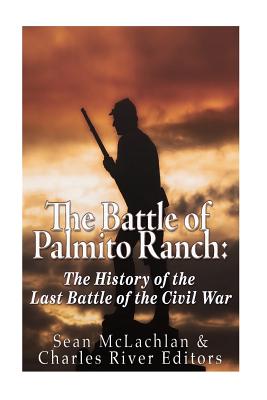The Battle of Palmito Ranch: The History of the Last Battle of the Civil War

The Battle of Palmito Ranch: The History of the Last Battle of the Civil War
*Includes pictures *Includes accounts of the fighting from soldiers on both sides *Covers the events of April 1865, Jefferson Davis' capture, and the aftermath of the battle *Includes online resources and a bibliography for further reading *Includes a table of contents By the close of 1864, Abraham Lincoln had been reelected, the Union army had taken Nashville from General Hood, and Sherman had concluded his total war, "slash-and-burn" march of destruction to Savannah, Georgia, offering it as a Christmas present to Lincoln. Nevertheless, with everything seemingly falling to pieces, the South still held out hope of some sort of miracle, and Davis even attempted to send a peace delegation to meet with Lincoln in the early months of 1865. On January 28, 1865 as Union General Ulysses S. Grant was continuing to lay siege to Lee's army at Petersburg, Virginia, Davis sent three commissioners headed by Vice-President Stephens to initiate informal peace talks with Lincoln. By February 3, however, the talks, known as the Hampton Roads Conference, came to a stalemate as Lincoln would accept nothing less than total union, while Davis would only accept Southern independence. Even at that point, the South was clearly on its last legs. General George H. Thomas destroyed John Bell Hood's Confederate army at the battles of Nashville and Franklin, leaving only two large Confederate armies still in the field. Lee's army was weakened by desertion, lack of supplies and casualties, and Joseph E. Johnston's army could barely resist against Sherman's army as it was advancing north toward Virginia. To most observers, the South was clearly reaching its end, but Davis had no intention of quitting the war. Even while he was fleeing, he attempted to order Confederate generals in the field to keep fighting. On April 9, 1865, Lee formally surrendered his weary army to Grant at Appomattox. Appomattox is frequently cited as the end of the Civil War, but there still remained several Confederate armies across the country, mostly under the command of Johnston, the same commander who arrived with reinforcements by rail during the First Battle of Bull Run and gave the South hope with victory in the first major battle. But on April 26, 1865, Johnston defied Davis's orders and surrendered all of his forces to General Sherman. Over the next month, the remaining Confederate forces would surrender or quit. Thus, by May, millions of Americans were breathing a collective sigh of relief that the C
Descrierea produsului
*Includes pictures *Includes accounts of the fighting from soldiers on both sides *Covers the events of April 1865, Jefferson Davis' capture, and the aftermath of the battle *Includes online resources and a bibliography for further reading *Includes a table of contents By the close of 1864, Abraham Lincoln had been reelected, the Union army had taken Nashville from General Hood, and Sherman had concluded his total war, "slash-and-burn" march of destruction to Savannah, Georgia, offering it as a Christmas present to Lincoln. Nevertheless, with everything seemingly falling to pieces, the South still held out hope of some sort of miracle, and Davis even attempted to send a peace delegation to meet with Lincoln in the early months of 1865. On January 28, 1865 as Union General Ulysses S. Grant was continuing to lay siege to Lee's army at Petersburg, Virginia, Davis sent three commissioners headed by Vice-President Stephens to initiate informal peace talks with Lincoln. By February 3, however, the talks, known as the Hampton Roads Conference, came to a stalemate as Lincoln would accept nothing less than total union, while Davis would only accept Southern independence. Even at that point, the South was clearly on its last legs. General George H. Thomas destroyed John Bell Hood's Confederate army at the battles of Nashville and Franklin, leaving only two large Confederate armies still in the field. Lee's army was weakened by desertion, lack of supplies and casualties, and Joseph E. Johnston's army could barely resist against Sherman's army as it was advancing north toward Virginia. To most observers, the South was clearly reaching its end, but Davis had no intention of quitting the war. Even while he was fleeing, he attempted to order Confederate generals in the field to keep fighting. On April 9, 1865, Lee formally surrendered his weary army to Grant at Appomattox. Appomattox is frequently cited as the end of the Civil War, but there still remained several Confederate armies across the country, mostly under the command of Johnston, the same commander who arrived with reinforcements by rail during the First Battle of Bull Run and gave the South hope with victory in the first major battle. But on April 26, 1865, Johnston defied Davis's orders and surrendered all of his forces to General Sherman. Over the next month, the remaining Confederate forces would surrender or quit. Thus, by May, millions of Americans were breathing a collective sigh of relief that the C
Detaliile produsului












